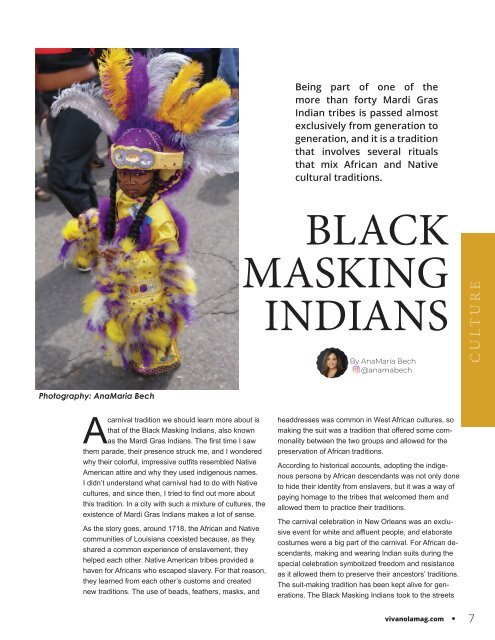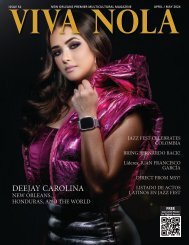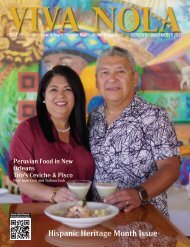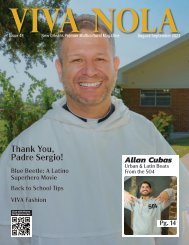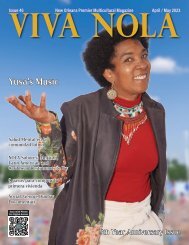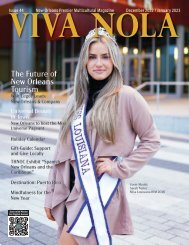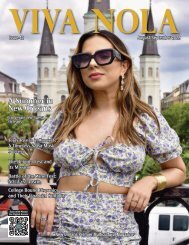VIVA NOLA February-March 2024
Variety bilingual publication that highlights the accomplishments of the Latino community. Made in New Orleans, Louisiana, USA
Variety bilingual publication that highlights the accomplishments of the Latino community. Made in New Orleans, Louisiana, USA
You also want an ePaper? Increase the reach of your titles
YUMPU automatically turns print PDFs into web optimized ePapers that Google loves.
Being part of one of the<br />
more than forty Mardi Gras<br />
Indian tribes is passed almost<br />
exclusively from generation to<br />
generation, and it is a tradition<br />
that involves several rituals<br />
that mix African and Native<br />
cultural traditions.<br />
BLACK<br />
MASKING<br />
INDIANS<br />
By AnaMaría Bech<br />
@anamabech<br />
CULTURE<br />
Photography: AnaMaria Bech<br />
Acarnival tradition we should learn more about is<br />
that of the Black Masking Indians, also known<br />
as the Mardi Gras Indians. The fi rst time I saw<br />
them parade, their presence struck me, and I wondered<br />
why their colorful, impressive outfi ts resembled Native<br />
American attire and why they used indigenous names.<br />
I didn’t understand what carnival had to do with Native<br />
cultures, and since then, I tried to fi nd out more about<br />
this tradition. In a city with such a mixture of cultures, the<br />
existence of Mardi Gras Indians makes a lot of sense.<br />
As the story goes, around 1718, the African and Native<br />
communities of Louisiana coexisted because, as they<br />
shared a common experience of enslavement, they<br />
helped each other. Native American tribes provided a<br />
haven for Africans who escaped slavery. For that reason,<br />
they learned from each other’s customs and created<br />
new traditions. The use of beads, feathers, masks, and<br />
headdresses was common in West African cultures, so<br />
making the suit was a tradition that offered some commonality<br />
between the two groups and allowed for the<br />
preservation of African traditions.<br />
According to historical accounts, adopting the indigenous<br />
persona by African descendants was not only done<br />
to hide their identity from enslavers, but it was a way of<br />
paying homage to the tribes that welcomed them and<br />
allowed them to practice their traditions.<br />
The carnival celebration in New Orleans was an exclusive<br />
event for white and affluent people, and elaborate<br />
costumes were a big part of the carnival. For African descendants,<br />
making and wearing Indian suits during the<br />
special celebration symbolized freedom and resistance<br />
as it allowed them to preserve their ancestors’ traditions.<br />
The suit-making tradition has been kept alive for generations.<br />
The Black Masking Indians took to the streets<br />
vivanolamag.com 7


